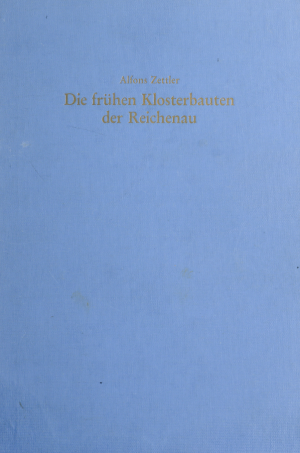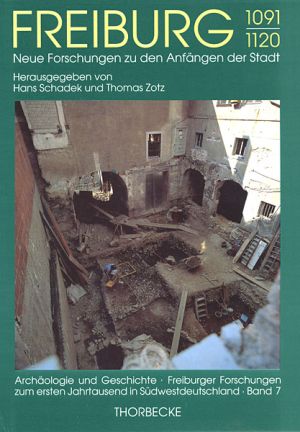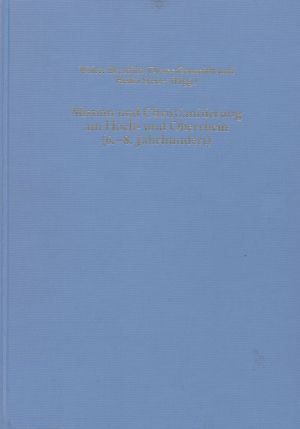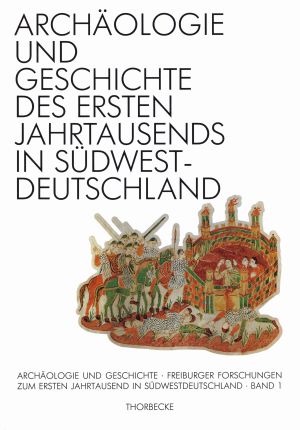Zettler, Alfons
Die frühen Klosterbauten der Reichenau: Ausgrabungen - Schriftquellen - St. Galler Klosterplan
Reichenau Monastery, founded in 724 by Bishop Pirmin, developed into a important sanctuary in the Franconian Empire during the eighth century. Equipped with a famous library and a well-known school, the Augia was one of the outstanding spiritual centers in early medieval Europe. Alfons Zettler has reconstructed the early architectural history of the monastery in years of research. His research draws from many written and pictorial sources. The focus, however, is the archaeological observations made by the author from 1970 to 1984 on site. In detail, he discusses the development of farm buildings, residential tracts and churches of the monastery district on the basis of the excavation findings. Maps, plans, historical views and photographs accompany the text. An appendix contains excavation documentation and remarks by Helmut Schlichterle on the prehistoric settlement of the monastery square. The book conveys important findings of modern medieval archeology and gives a fascinating insight into the everyday life of an early medieval monastic community.
Die Burgen im mittelalterlichen Breisgau: I. Nördlicher Teil. Halbband A-K
Of the once numerous medieval castles in the Markgräflerland and in the Breisgau, only a few survived the eventful and warlike centuries of the early modern period on the Upper Rhine. A small number of more or less well-preserved ruins are contrasted by a considerable number of vanished castles, of which only written records and field names still bear witness. The Castle Book, which was compiled in the Department of Regional History at the Historical Seminar of the University of Freiburg i. Br., contains a richly illustrated catalog of all the castles and castle sites of the Breisgau region in its medieval extension and thus offers for the first time a complete inventory of the high and late medieval castle landscape there. It will be published in four volumes, the first two parts covering the northern Breisgau, two more are planned for the southern Breisgau.
Die Burgen im mittelalterlichen Breisgau: II. Südlicher Teil Halbband A–K
Of the once numerous castles in medieval Breisgau, only a few survived the turbulent and warlike centuries of the early modern period on the Upper and High Rhine. A small stock of more or less well-preserved ruins contrasts with a considerable number of vanished castles, of which only written records and field names still bear witness. The Burgenlexikon, which was compiled in cooperation between the Department of Regional History of the Historical Seminar of the University of Freiburg i. Br. and the Historical Institute of the Technical University of Dortmund, contains a richly illustrated catalog of all castles and castle sites of the Breisgau region in its medieval extent and thus offers for the first time a complete inventory of the high and late medieval castle landscape there. It will be published in four parts, of which so far the two volumes for the northern Breisgau and with this volume now also the first for the southern Breisgau are available.
Die Reichenauer Mönchsgemeinschaft und ihr Totengedenken im frühen Mittelalter
The Bodenseekloster Reichenau, founded around 724 by the Bishop Bishop Pirmin, has left in Reichenauer Fraternity Book and in two death books extensive name directories from the time before the millennium. Around 40,000 people were enrolled in these commemorative books during the earlier Middle Ages for the purpose of liturgical prayer. With the entry of the name in the commemorative books placed on the altar, the medieval man combined the idea of the entrance into the "heavenly book of life"; he hoped to have an everlasting presence in the liturgy and the prayers of the monks, closeness to God and the salvation of his soul. The core of the Reichenau memorial tradition, the lists of names concerning the Reichenau Convention and the memorial in the island monastery are the subject of this book. The traditionally edited and presented transmission complex not only reflects the varied history of the Abbey in Lake Constance and its monastic community from its founding to the Golden Age to the High Middle Ages, but also provides an insight into the history of Western monasticism and many aspects of social, political and ecclesiastical life of that time.
Burgen im Breisgau: Aspekte von Burg und Herrschaft im überregionalen Vergleich
Scholars from several nations and disciplines met in March 2009 in the former Cluniac Priory of St. Ulrich near Bollschweil to discuss aspects of medieval castles. The invitation was extended by the project group "The Castles in Medieval Breisgau" at the Universities of Dortmund and Freiburg i. Br., which aims at a complete survey of the castles of an old medieval landscape. At the conference, the results of many years of research were placed in a scientific context and compared on a supra-regional level.
Freiburg 1091-1120: Neue Forschungen zu den Anfängen der Stadt
Die in Freiburg erst vor wenigen Jahren in Gang gekommene archäologische Erforschung des Stadtgrundes und der frühen Siedlungselemente, die vor allem in den Kellerbereichen von später neu errichteten Bauten erhalten blieben, hat die Diskussion um die Entstehung Freiburgs und um die Frühzeit der von den Zähringern begründeten städtischen Siedlung neu aufleben lassen. Die ältere Auffassung, die meinte, man halte mit dem berühmten Marktprivileg Konrads von Zähringen aus dem Jahre 1120 den urkundlichen Beweis für eine planmäßig durchgeführte Gründung der Stadt auf weitgehend unvorbereitetem Gelände in der Hand, sieht sich nun wieder mit der gegenteiligen, durch die archäologischen Befunde gestützten Ansicht konfrontiert, die die Entstehung Freiburgs als einen zeitlich gestreckten Vorgang zu deuten geneigt ist. Damit aber tritt auch das andere, von den Marbacher Annalen überlieferte, durch Eduard Heycks frühes Verdikt nie recht ernst genommene »Gründungsjahr« Freiburgs, nämlich 1091, wieder in das Blickfeld des Interesses. Es zwingt dazu, die Frage nach den Anfängen statt nach dem Anfang - von Markt und Stadt zu stellen. Diesen Versuch unternahm im »Jubiläumsjahr« 1991 die im vorliegenden Band vereinigte, vom Historischen Seminar der Universität und vom Stadtarchiv Freiburg veranstaltete Reihe von sieben Vorträgen. Es zeigte sich: Seit spätrömischer Zeit bot der gut strukturierte, durch Verkehrswege erschlossene weitere Raum um Freiburg günstige Voraussetzungen für eine wirtschaftliche Nutzung und intensive Besiedlung und damit für die Entstehung stadtähnlicher Zentren mit zentralörtlichen Funktionen wie Breisach, Sasbach, Riegel und die befestigte Großsiedlung auf dem Zähringer Burgberg. Seit den 1090er Jahren lagen die politischen Voraussetzungen vor für eine Konsolidierung der wirtschaftlichen Prosperität mit der Anlage einer jetzt archäologisch nachgewiesenen, unter dem Schutz der Burg auf dem Schloßberg stehenden Siedlung. Die Marktprivilegierung von 1120 schloß die vorausgegangene Phase organisatorisch und rechtlich ab. Auf diesem Fundament bildete sich der herrschaftliche Markt zur mittelalterlichen Stadt aus, deren sozial- und verfassungsgeschichtliche Entwicklung in den ersten anderthalb Jahrhunderten zwar im ganzen nur umrißartig, gelegentlich aber, vor allem im Hinblick auf die führenden Familien, unerwartet detailliert dargestellt werden kann.
Mission und Christianisierung am Hoch- und Oberrhein (6. - 8. Jahrhundert)
The Christianization of the Germanic peoples of Western Europe began with the conversion of Clovis, king of the Franks, who, according to the report of the historian Gregory of Tours, vowed his conversion to the Christian Catholic faith in a battle against the Alemanni in 496/97. This event of "world historical significance" was recalled and honored in 1996/97, 1500 years after the legendary Battle of the Alemanni, in numerous events, exhibitions and publications. In March 1997, historians, theologians and archaeologists met in Bad Säckingen at the invitation of the city for a scientific colloquium to examine the missionary work and Christianization of the Alemanni, which probably began only decades after Clovis' baptism. The concentration on the area between the High and Upper Rhine and the interdisciplinary dialogue led to new insights and results, which are presented in this volume.
Archäologie und Geschichte des ersten Jahrtausends in Südwestdeutschland
The research association "Archäologie und Geschichte des ersten Jahrtausends in Südwestdeutschland", founded in 1984, has set itself the goal of exploring the early history of the German southwest in an interdisciplinary conversation. The first volume of the series of the same name contains 15 contributions by renowned historians who present the latest results of research from their fields of activity - provincial Roman and early historical archaeology and medieval regional history. The geographical focus of the investigations is the area between the upper Rhine and the upper Danube, between the Swiss Jura and the Swabian Alb, the Burgundian Gate and the Franconian Ries. The time span ranges from the Celtic period and the Roman occupation of the country to the era of the formation of high medieval noble houses and sovereign territories. The research association pays special attention to periods of upheaval in history, the change of populations and the transformation of social and economic structures as well as the introduction of technical innovations. The book, which is equipped with an extensive index and many illustrations, provides a clear introduction to the methodology and working methods of ancient history. It is therefore an indispensable compendium for students and scholars, but also for the layman interested in regional studies.
Der Südwesten im 8. Jahrhundert aus historischer und archäologischer Sicht
On October 28 and 29, 1994, the Freiburg Research Network "Archaeology and History of the First Millennium in Southwest Germany" organized a colloquium at the University of Freiburg with the topic "The Southwest in the 8th Century from a Historical and Archaeological Perspective".
During the colloquium in 1994 such a period of upheaval was to be looked at more closely with the 8th century. This period, which cannot be strictly defined as a century, shows its transitional character in various respects, e.g. in political history with the striking end of the Alemannic duchy in the middle of the century and the integration of Alemannia into the Frankish Empire, in settlement archaeology with the flowing end of the row grave custom, the typical burial custom in the Merovingian Empire, and thus of the so-called row grave civilization. It was the intention of the colloquium to work out selective and long-term changes of this kind in the concentration on a region characterized by manifold historical traditions (Celts, Romans, Alemanni) as well as in the specific comparison with other historical landscapes and to approach the topic both in a general overview and in individual case studies.















